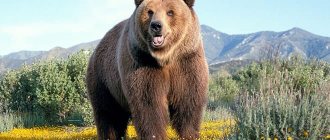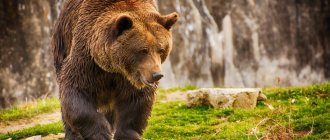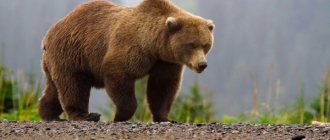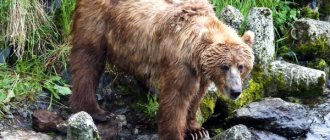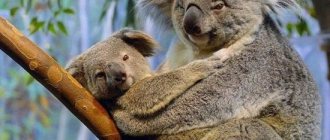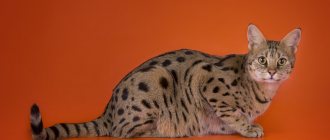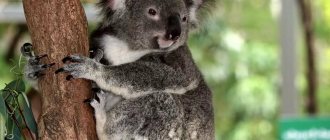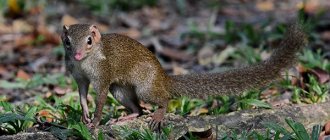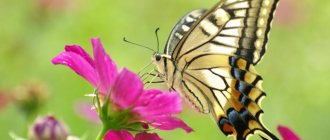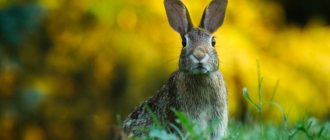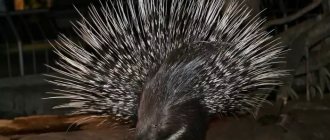Kinkajous are small golden-brown arboreal mammals native to the tropical forests of Central and South America. Also known as honey bears, kinkajous have become popular in the exotic pet trade. In captivity they are usually friendly, playful and curious.
However, they are easily frightened and can become aggressive towards their owners. They can also be difficult to place as they require a lot of space to exercise.
And they need a varied diet that mimics what they eat in the wild. Overall, this is a high-maintenance pet that requires a knowledgeable and dedicated owner.
View overview
COMMON NAME : Kinkajou, the honey bear.
SCIENTIFIC NAME : Potos flavus.
ADULT SIZE : from 40 to 60 cm in length, weighs from one to four kilograms
How long they live : 20 to 25 years in captivity, but some can reach over 40 years.
Kinkajou Behavior and Temperament
In the wild, kinkajous spend most of their time in the rainforest canopy and are nocturnal (more active at night). Although they somewhat resemble monkeys, they are actually more closely related to raccoons and red pandas.
Wild kinkajou feast on fruit and honey while climbing trees, which is how they get their nickname “honey bear.” They are somewhat social animals, spending some time alone and some time in groups, grooming, sleeping and playing together.
When the kinkajou is raised in captivity from an early age, it can be quite tame.
But they will still retain their wild characteristics, which makes them unpredictable. And they will bite if they feel threatened, so it's best to keep them separate from any other pets in the house.
As pets, kinkajous tend to be active and curious, and they like to get involved, requiring a lot of hands-on care from you to keep them entertained.
Sometimes they can be noisy. They have a variety of vocalizations, including soft snorts, chirps, or whistles; a “barking” sound similar to a yapping dog; and a high-pitched scream that can be very loud.
Appearance and features
Photo: Kinkajou Animal
An adult kinkajou weighs from one and a half to three kilograms, and its body length is 40-60 centimeters. They also have a flexible, prehensile tail approximately equal to the length of the animal’s body. Standing on four limbs, the animal reaches approximately 20-25 centimeters at the withers.
The kinkajou has an oval head, a slightly elongated muzzle and rounded ears that are set low and set wide apart. The large eyes and nose shape resemble those of a bear. At the same time, the tenacious tail, which the animal uses to help itself when moving, outwardly makes it similar to monkeys, which caused confusion in the initial definition of the family. The sense organs of kinkajou are developed differently, and hearing and smell are more developed than vision, so these animals navigate in space, relying primarily on them.
The kinkajou's tongue is very flexible and is about 10 centimeters long, which, to justify its name, allows the animal to extract nectar from flowers and honey from beehives. Their tongue, unfortunately, is primarily adapted for this purpose and is not at all intended for animal food, so their predatory diet includes only very small creatures.
The limbs of the kinkajou are strong, well developed, dense, and of medium size. The poto's paws are also well developed, have no hair on the inside and are shaped like human palms, which brings it closer to primates. The hind legs are longer than the front legs, which is due to the need to hold tightly to the branch along with the tail, hanging down while feeding. The claws are strong and strong - this is due to the fact that the animal spends its entire life in the trees.
The kinkajou's joints, in addition to strong limbs, are highly mobile - their paws are able to easily make a 180-degree turn without changing the position of the limbs, which allows them to easily and quickly change direction depending on the situation. The animal's fur is soft and velvety to the touch, thick and long, approximately five millimeters in length. The outer fur is brownish brown, while the inner fur is slightly lighter and has a golden tint. The animal's muzzle is covered with brown fur and is darker than the overall color, which makes it seem as if it is slightly covered with dirt or dust.
The tail of the kinkajou, unlike other representatives of the raccoon family, is single-colored and has only a slightly darker fur color than the rest of the body. The poteau's tail is very mobile and is primarily designed for balance when moving quickly, as well as for a more reliable grip on branches while hanging upside down. They also use their tail to warm themselves during sleep and in cool weather, wrapping themselves in it and covering themselves with it.
Kinkajou have marker (scent) glands in their mouth, neck and abdomen, with which they mark their territory and leave a mark on the route they take. Female kinkajou also have a pair of mammary glands located above the abdomen.
How to arrange housing for Kinkajou
The kinkajou needs as large an enclosure as possible. At a minimum, it should be a meter wide, 2-3 meters long and 2 meters high. Large enclosures for large parrots are often suitable for kinkajous.
Make some branches, ledges and shelves, as well as climbing ropes inside the fence. You can also include some items designed for larger parrots, such as wooden ladders, rope swings, and hanging ropes with pieces of wood.
Avoid anything with a chain, as this can damage the kinkajou's fingers.
Include a hammock or nest box in the enclosure where your animal can go to feel safe and rest. Fleece is a good material for making a hammock. And many owners fashion a nest out of a small plastic storage container lined with fleece and attached to the side of the enclosure.
Most owners believe that it is best to limit the freedom of the kinkajou when they cannot supervise the animal.
The ideal Kinkajou owner would be as nocturnal as their pet, but this is not an option for many people. But you should still allow your kinkajou to play and exercise outside at least a few hours a day for socialization and to prevent boredom.
Kinkajou-proof the area of your home where you allow it to play, just as you would with a human toddler - hide power cords, cover outlets, remove breakable items, etc.
Kinkajou, as a rule, is sufficient at room temperature.
Just make sure that the temperature does not exceed 18-24 C. In addition, the humidity level should be at least 50 percent. These animals can also benefit from an outdoor enclosure for greater environmental enrichment.
Set it up just like you would indoors, but make sure your kinkajou always has access to shade. Also, always keep an eye on your pet when they are outside in case there are predators or inclement weather nearby.
What do kinkajou eat in the wild?
Kinkajous have an incredible sweet tooth. The basis of their diet consists of tropical fruits, crustaceans, and insects. The animals also love to feast on honey from the hives. They often raid the nests of wild bees. Thanks to their long tongue, they can easily get and eat honey directly from the hives.
Kinkajous also drink flower nectar, thereby also fulfilling the mission of pollinators. During lunch, pollen settles on the animal’s face and its movements along the “food route” are transferred to the flowers of other plants. When a kinkajou manages to discover a clutch of eggs or catch a small mammal or bird, it feasts on them too.
What to feed kinkajou
Kinkajous primarily feed on fruits, nectar, and honey in the wild. But given the opportunity, they will sometimes eat insects, eggs, frogs and other plants and flowers.
In captivity, they can be fed commercial primate foods, which will provide a nutritional base for their diet with many vitamins and minerals.
They should also be given a variety of fruits (especially tropical ones) such as bananas, papayas, mangoes, melons, kiwis, grapes, pineapples and pomegranates. They may also contain seasonal vegetables and some protein, such as boiled chicken or eggs.
Experts recommend avoiding strawberries, citrus fruits, avocados, broccoli and onions, as well as dairy products, chocolate and caffeine.
Consult your veterinarian about the appropriate amount and variety of food for your animal, as it depends on age, size and activity level.
It is usually best to feed your kinkajou in the evening when he is awake and looking for food, but ask your veterinarian for the ideal feeding schedule.
Heavy ceramic food bowls that cannot be tipped over, or bowls that can be securely attached to the wall of the enclosure, work well for feeding.
Fresh water should also be provided at all times. However, the water in the bowl is likely to be spilled or contaminated, so it is recommended to use a water bottle with a sipper tube that attaches to the side of the body.
Make sure your kinkajou knows how to drink from the sipper tube before removing the water bowl.
Flower bear kinkajou
On the left in the photo, the kinkajou, holding only its fifth limb, sends food directly into its mouth. The main diet of the predator differs significantly from the diet of other members of the family and consists almost of food of plant origin.
The kinkajou animal only eats sweet fruits such as legume seeds, forest bee honey, flower nectar and nuts. The animal's favorite delicacy is mango and avocado, bananas and guava, dates and mango. But his relative, the striped raccoon, eats everything.
The kinkajou bear, as it is sometimes called, does not disdain chicks, eggs and insects on occasion. In the branches, among his family, he has no equal in performing complex acrobatic stunts. He reaches fruits by clinging only with his fifth limb and tearing them from thin branches. Having a long, 12-centimeter tongue, the animal is able to reach hard-to-reach places by licking the nectar or honey of wild bees.
General health problems
A veterinarian who specializes in kinkajou may be difficult to find even in Moscow or St. Petersburg, but it is very important to find a good veterinarian before purchasing your pet.
Although these are generally healthy animals, an annual health check is still ideal. Your veterinarian will likely recommend some vaccinations, including rabies and distemper, as well as deworming.
Additionally, Kinkajou should be spayed or neutered at around 6 months of age to prevent aggression due to hormones and some hormone-related medical problems such as cancer. In addition, kinkajou need to have their nails trimmed regularly to prevent their sharp claws from damaging you or your property.
Some kinkajous are predisposed to dental disease due to the high amount of sugar in their diet. Signs of this include lack of appetite, bad breath, and weight loss.
In this case, contact your veterinarian immediately; they should be able to advise you on proper oral hygiene for your pet.
Twilight state of the bear
1K 6 min.
I can’t speak for all the Indians, but at least one of their tribes had clearly never seen a real bear. This tribe was aware that bears actually exist. And apparently the tribe thought a lot about bears. And perhaps it even felt some inferiority due to the fact that all the other Indians were familiar with bears. And it had to happen that precisely this tribe, dreaming of bears, at the dawn of time met with a certain nameless beast, which had to be called something? So they called it a flower bear, that is, a kinkajou. These Indians probably imagined bears something like this. Or maybe they weren’t Indians. Who now knows where this beautiful, clearly Indian word “kinkajou” came from? However, many real Indians even today call this beast simply “boo” - apparently because he sometimes mutters something like “buboo”.
Photo: DIOMEDIA / DK Images
Well, we, residents of an officially bear country, can now laugh as much as we want at the naivety of those Indians of Central and South America - all the same, the kinkajou will forever remain a flower bear. And for the especially smart ones it is Potos flavus,
a predatory mammal of the raccoon family and the only member of the genus
Potos
. However, he doesn’t look much like a classic raccoon either. Kinkajou - he doesn't look like anyone else at all. And most of all, he doesn’t look like a bear, of course. This is as usual - a guinea pig doesn’t look much like a pig either. But who cares now?
So, the kinkajou, a wonderful strange animal from the forests of the warm part of America, in its homeland cannot in any way be considered an exotic pet - in Brazil, for example, and especially in Mexico, these flower bears are kept in houses no less often than cats. Or maybe even less often - who's counting them? Over time, the fashion for kinkajou spread to the north - and reached the point where Paris Hilton got her own flower bear. But something terrible happened there, like the kinkajou bit Paris right on the, scary to say, face. And his teeth are not like those of a child, his fangs are about a centimeter and a half long. In general, it is better not to give kinkajou to children. By the way, it is the bite of the owner in the face that is considered almost the calling card of this cute beast. This is because all the subsequently bitten faces at the wrong time reached out to the glorious false bear with kisses, so our Paris Hilton, it seems, was caught doing the same thing.
Well, who could resist? The kinkajou has velvety reddish thick fur and funny round ears growing on the sides, making the head look like a bathhouse gang. He also has big sad eyes and short legs, as well as tenacious front paws that look more like hands, and in general he is small, about the size of a cat, weighing about three kilos, and looks all plush. But it has a serious tail, as long as the rest of the kinkajou, that is, 40 centimeters - with this tail, our flower bear deftly grabs branches (for which he received another name - the tenacious-tailed bear), and when going to bed, he covers himself with it like a blanket. And he also has a very expressive tongue, 10-13 centimeters - sometimes the kinkajou seems to forget to put it away and sits there, showing it to the whole world, sort of teasing, and this is very funny. In fact, such a pagan is needed to obtain food: the kinkajou has a sweet tooth, and although it is considered a predator, its gastronomic preferences are rather vegetarian. He, just like a fairy, loves honey more than anything in the world, for which he is also called a honey bear, as well as flower nectar and fruits; however, if an insect, or an egg, or a small animal comes across his way, he will not refuse them either.
And he also has a very cute expression on his face - the kinkajou, while he sits with his mouth closed, looks like a touching orphan, hoping that one day the world will become at least a little kinder. How can you not caress and kiss someone like that? So she kissed Mademoiselle Hilton.
Well, when he opens his mouth, our cutie immediately looks like a saber-toothed tiger. In fact, the kinkajou is not at all considered dangerous and biting - on the contrary, it has a reputation as a nice, affectionate and friendly creature. It’s just that when dealing with a flower bear, you need to remember the main thing: it is a wild, forest animal, and does not have hundreds of generations of ancestors tamed by humans behind it. That is, to put it simply, the kinkajou is not an all-forgiving dog. And not even a cat.
The right kinkajou owners assure that their pets are affectionate and affectionate, like fairy-tale children, that they love to hug and be affectionate, and that there is not even a hint of deceit in their character. And those whom they bit with their sharp teeth or scratched with their powerful claws were themselves to blame for everything - respect and delicacy must be shown with kinkajou. And the understanding, for example, that this honey-flower bear is actually a nocturnal creature, which means there is no need to bother him during the day, wake him up and forcibly tear him away from his favorite nest. True, many kinkajous, as soon as the owner passes by the cage, consider it their duty to wake up and extend their arms to the person in the gesture “give me something tasty.” But this is so, for the love of food, and not at all in terms of cuddling. We will hug at dusk, when the kinkajou finally wakes up and is in the appropriate mood.
There are some doubts about the fact that kinkajou loves its owners so much. In my opinion, the flower bear is simply condescending to people. Well, or a little attached - and this is if you have only one. A couple of kinkajous will be more and more busy with each other, and the owner will be perceived by them as just a friendly banana dispenser. Cats, dogs and other animals are not interesting to them; however, the kinkajou can catch a mouse or hamster. And eat - in fact, another kinkajou is quite capable of clearing your house of rodents, but, to be honest, a cat will do it better.
So, during the day the kinkajou sleeps. And towards evening he wakes up and wants to refresh himself. There are no problems with feeding an exotic creature - the kinkajou is not picky, he willingly eats cat or dog food, oatmeal, yogurt, baby food, fruit, and will not disdain a piece of egg or boiled meat. Well, having refreshed himself, he will be ready to be friends - then the kinkajou will happily hang on his person. However, I would be careful not to kiss him on the nose - remember Paris Hilton! - but no one will stop you from stroking his soft fur or scratching his well-fed belly. You can even hold on to the tail.
When dealing with a flower bear, you must remember: he is a wild, forest animal.
Kinkajou is curious and somewhat hooligan, which comes from his raccoons. Therefore, you cannot leave him to walk around the house unattended - he must live in a very large cage, equipped with something like a tree, as well as all sorts of shelves, ropes, hammocks, twigs, strong toys and a house for sleeping. You don’t even have to worry about a special toilet place - the kinkajou sets up a toilet where inspiration strikes him, and does not intend to get used to any trays. Some especially decent flower bears, during a walk, feeling the need to relieve themselves, rush to their home cage (where, don’t flatter yourself, they will do everything in the drinking bowl or wherever it happens), but most of them don’t bother with such nonsense and irrigate the surroundings without getting off, for example , closet. Well…. But you have a kinkajou. Which, by the way, has virtually no smell.
When the kinkajou dreamily eats a banana, he looks relaxed like a sloth. In fact, he is fast, active, jumping and agile like a monkey, and limiting his life to a cage is cruel. In a word, in the evenings you will have to let him walk around the house, let the baby frolic. But only under human control! Well, for the rest of the night that you plan to sleep through, the kinkajou will have to be locked in a cage - and there he will entertain himself on his own. By the way, it would be nice if the cage was away from your sleeping place: the kinkajou likes to make noise. Not deafeningly, but still - he runs, sniffles, slurps, strums something, checks the teeth of toys, moves something from place to place, pronounces, grunts, squeals, barks, and sometimes suddenly he screams! Moreover, the scream of a kinkajou is very similar to the piercing scream of a nervous human lady, so that unprepared people’s hearts just break.
A kinkajou walking around the house jumps on the furniture, swings on the curtains, hangs on the chandelier, grabs everything that can be grabbed, and generally has fun to the fullest, so it is better to remove everything fragile and valuable from its path. He plays pranks with such an innocent look that you can’t take your eyes off him. Actually, that’s why we need him, so that we can’t take our eyes off him: the kinkajou is charming even when he’s sleeping, but when he’s awake, he’s completely irresistible.
If you're lucky, your unobtrusive friendship with a kinkajou can last a long time - on average they live about a quarter of a century, but flower bears (costing a couple of thousand dollars per unit) have been known to live up to 40 years. The main thing here is that his life should be calm: the kinkajou should not be frightened, upset by too bright light, exposed to drafts, overfed and frozen. But it is quite possible to walk with him - in warm weather and, of course, on a leash, otherwise he will hide in the branches of the first birch tree he comes across, and you will be the only one to see him. How will you then live without kinkajou?
Where to buy kinkajou
If you are ready for a home kinkajou, find a reputable breeder. Expect to pay an average of RUB 100,000. Do not buy an animal online as it may be a scam or you may end up with a sick animal.
Instead, take the time to visit the animal and ask the seller questions. The seller must provide you with detailed information about the origin, age, health and temperament of the animal.
Look for friendly and active kinkajous. His eyes should be bright and he should appear healthy (no visible bones). If possible, ask to see him eat.
Also, pay attention to the environment in which the seller keeps his animals. Enclosures should be large and clean with adequate ropes, branches and other furniture. If a seller refuses to show you their business, that's a serious red flag.
Economic importance
Kinkajous are sometimes kept as pets. But their content raises some difficulties. Natural good nature and cheerful disposition can give way to unexpected aggression after a few years. After all, a wild animal is a wild animal!
Sweet bear.
People hunt the kinkajou for its valuable fur. In addition, in some countries its meat is eaten.
If you find an error, please select a piece of text and press Ctrl+Enter.
